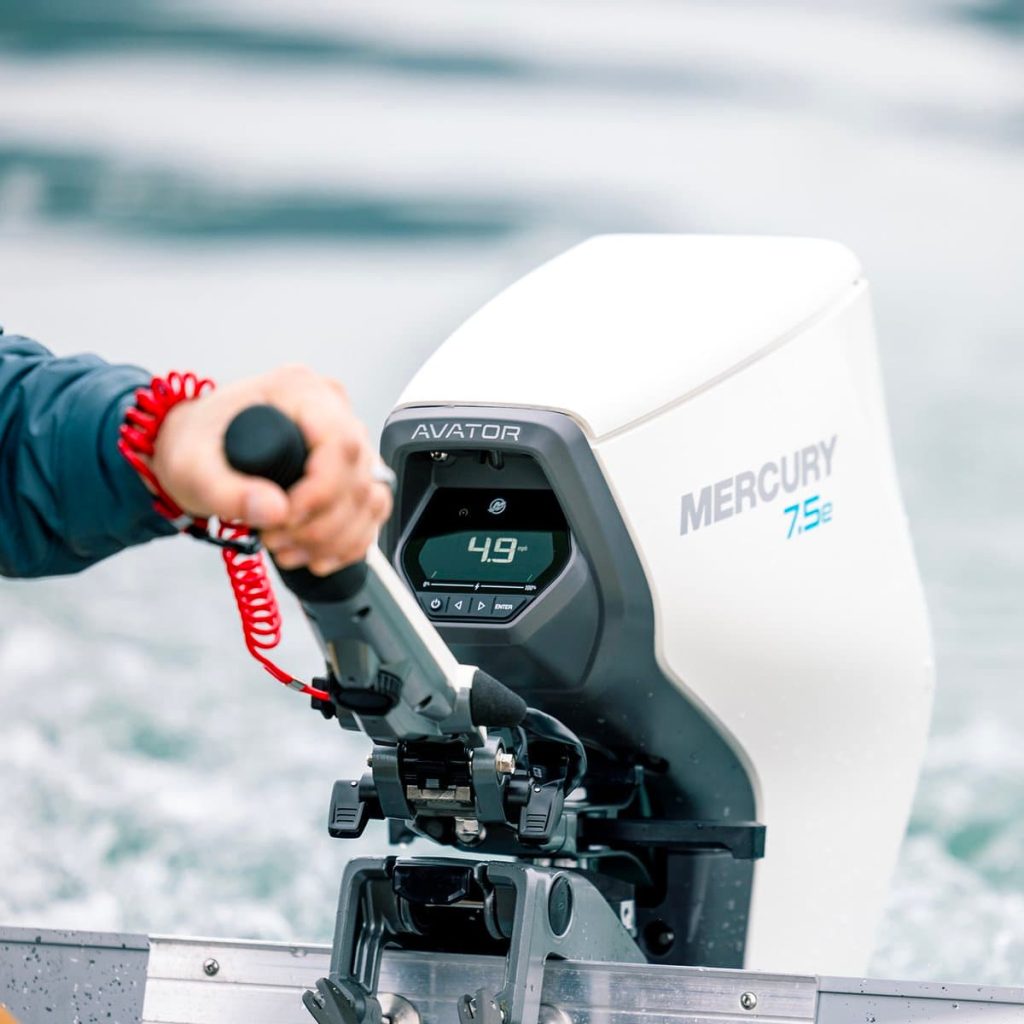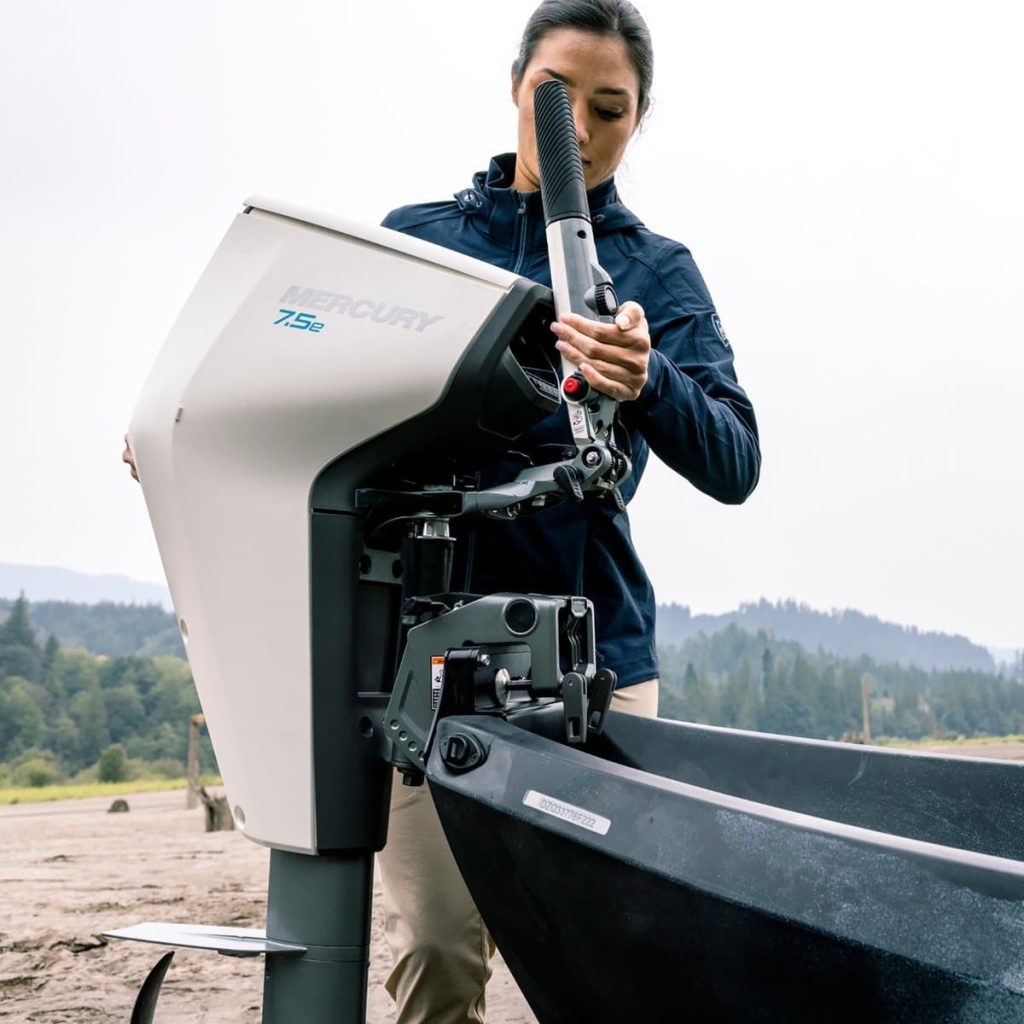
Mercury took to the CES 2023 show to unveil its latest electric outboard motor for small boats. Meet the Mercury Avator 7.5e.
The unit is an all-in-one propulsion package that includes the motor, battery, and electronics in a self-contained system. It is designed for small watercraft that accept transom-mount outboards.
The Avator 7.5e delivers on Mercury Marine’s recent pledge to double down on electric boating.
As Mercury Marine’s president Chris Drees explained, the company’s extensive history in the marine industry was key in facilitating its expansion into electric drives:
We are excited to formally introduce the Avator 7.5e electric outboard to the world. As the innovation leader in the marine industry, both in internal combustion products and now electric propulsion, we have the resources and knowledge to make boating more accessible to more people, while building on our commitment to sustainability. The Avator program is helping us do this in new and exciting ways.

Mercury Avator 7.5e outboard launched
The Avator 7.5e isn’t a particularly powerful system, with just a 750W continuous-rated motor. That’s equivalent to one horsepower, though the electric drive means that the higher torque system can do more with less power.
Mercury says that the motor performs closer in performance to a Mercury 3.5hp FourStroke outboard with comparable speed and acceleration figures.
Part of the reason the motor competes so well against more powerful gas engines is that it uses a transverse flux electric motor. That design has a different copper coil winding design that increases low-speed torque and efficiency.

A watertight lid on the top of the motor’s console opens to reveal a battery compartment. Mercury’s 1 kWh battery packs slide into the console and are swappable to allow longer range without needing to stop and recharge.
A single 48V battery is said to be good for only 45 minutes when motoring flat out, though slower speeds help increase that run time. Carrying a second or third battery makes it easy to stay out longer or travel farther distances. The 16-pound (7 kg) batteries were developed in partnership with Mastervolt and engineered exclusively for marine applications. The power packs have passed drop tests and are IP67 rated for water resistance.
The Mercury Avator 7.5e includes a multipurpose tiller handle that can adjust up, down, left, or right for comfortable steering from any position or with either hand and also folds down to become a convenient carrying handle. The entire unit weighs 43 pounds (19.5 kg) with the transom mount, meaning it can be carried for short distances. The boat can be beached or docked, and then the entire drive system can be removed and brought along with the boater.
That was part of the design to make use of electric propulsion’s unique advantages, as Mercury Marine’s vice president, Tim Reid, explained:
Every aspect, from the controls, props and digital gauges to a mobile app, are designed as parts of a complete propulsion system specifically designed for the advantages of electric propulsion.
Mercury reportedly has larger Avator motors in the works, including the Avator 20e and 35e, which are expected to hit the market later this year.
Electrek’s Take
I’m quite impressed with the design. The Avator 7.5e looks slick and easy to use, and I like the way it can be easily removed. I imagine that theft could be an issue (this certainly won’t be a cheap system), so being able to easily carry it with you instead of leaving it on a docked boat is a nice feature.
The 1 kWh batteries aren’t particularly large, but the unit isn’t particularly powerful either, so it’s not like you’ll be burning through the batteries in 20 minutes. Having a few spares is a good idea, and they’re around the size of a small gas can that many boaters would already be accustomed to carrying onboard.
The power isn’t very high, but it’s likely fine for someone who just wants to take their 12-foot skiff out for some fishing on the lake. Obviously, you’re not going to be taking this motor out into large gulfs, oceans, or raging rivers, but for fairly calm waterways, it seems sufficient. And of course, this won’t compare to the motors that power larger electric watercraft since those are entirely different beasts.
The whole system looks like it’d be quick and easy to install, turning a boat into an electric boat in just a couple of minutes. I’d love to try one of these out because, so far, I’m quite impressed with what I’m seeing on paper.
And it definitely looks a lot nicer than the motor in my cheap Chinese electric boat.
FTC: We use income earning auto affiliate links. More.





Comments